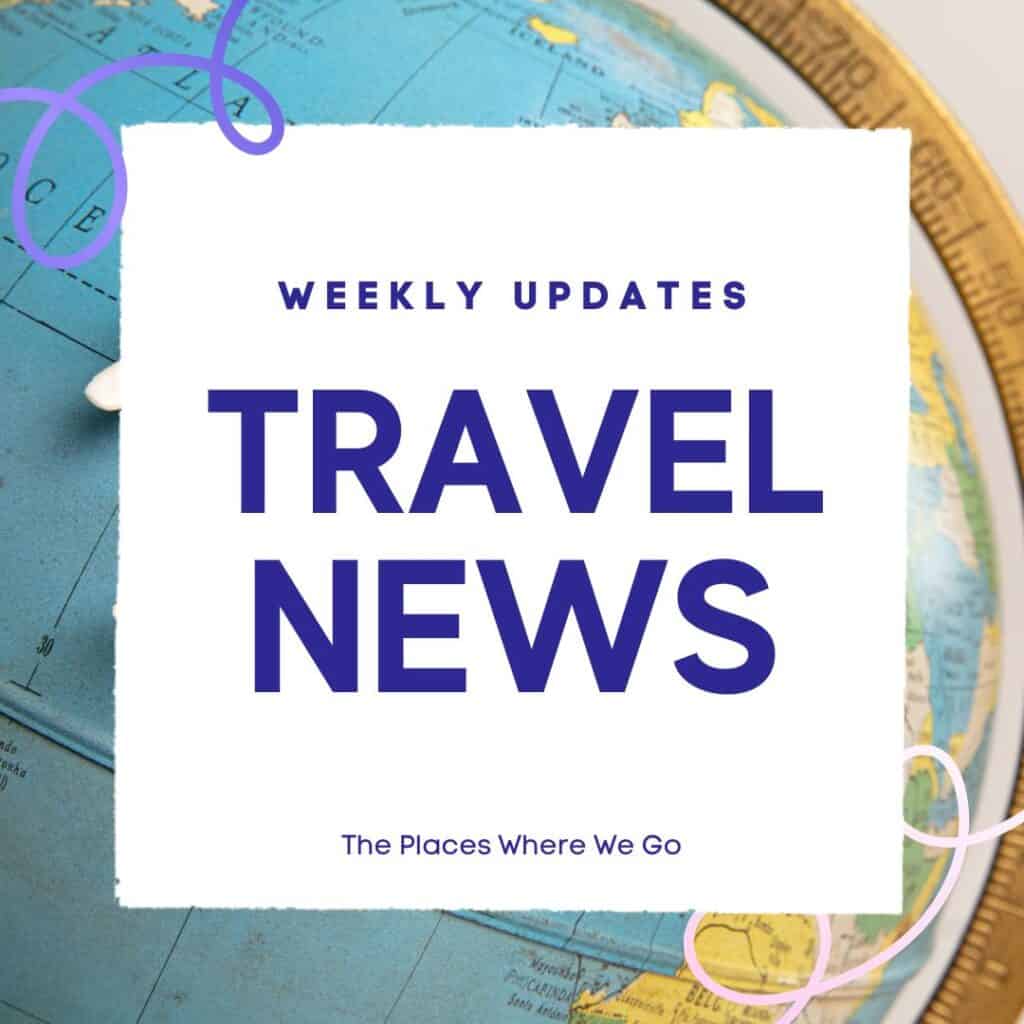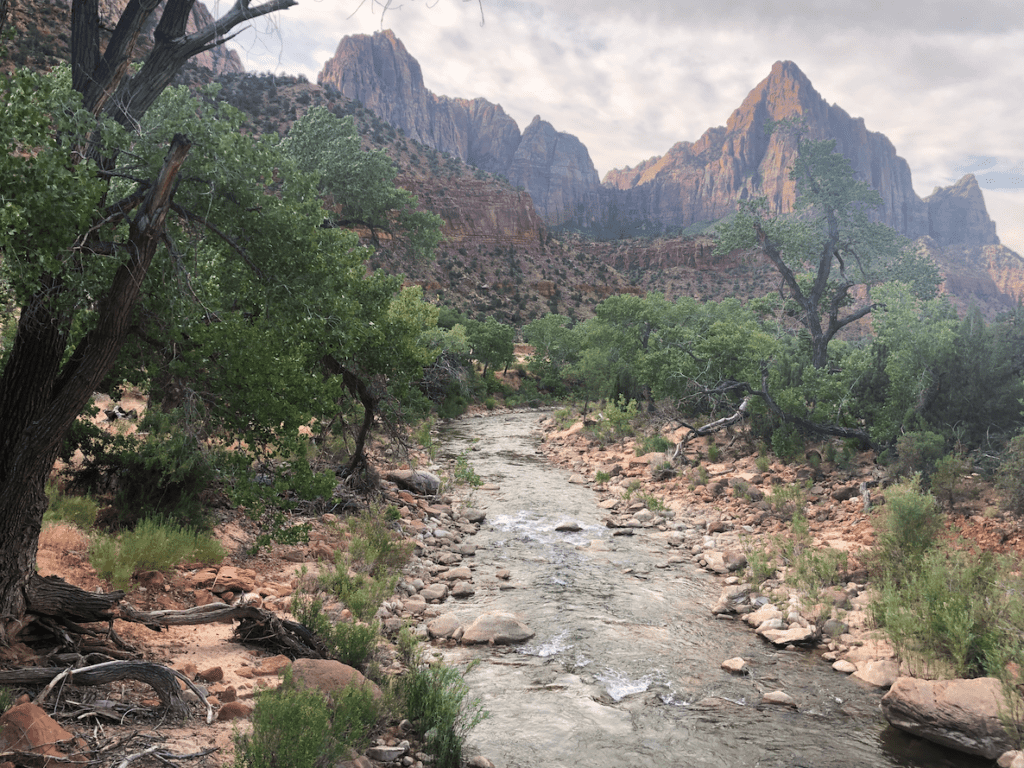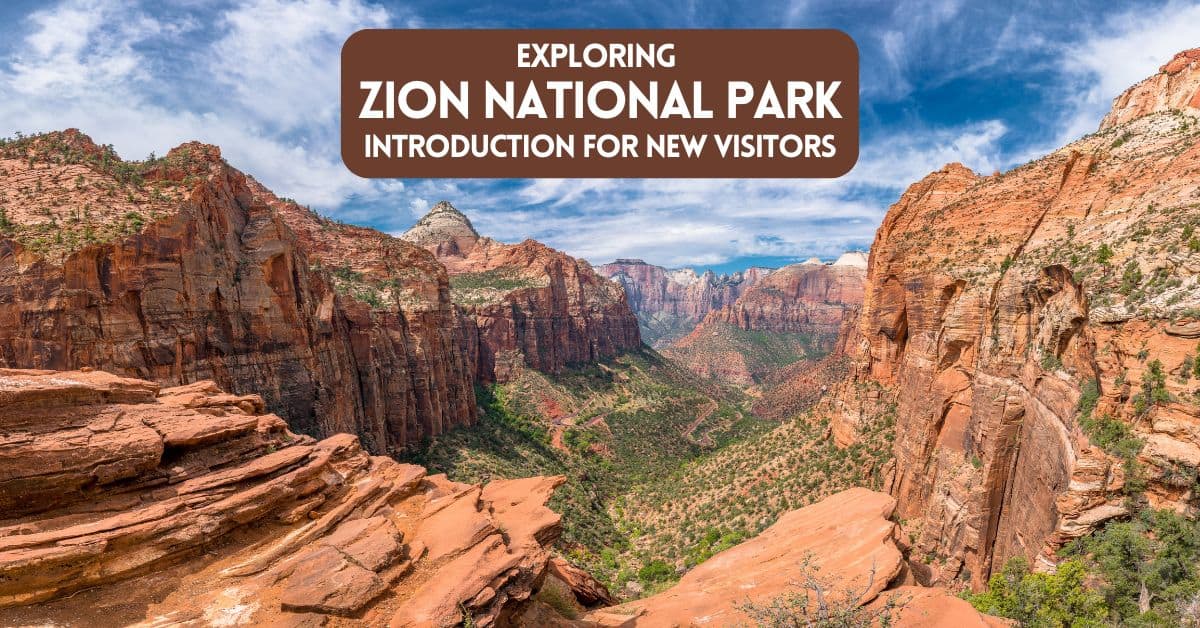Exploring Zion National Park – An Introduction For New Visitors
Are you thinking about exploring Zion National Park? It is a fantastic destination in Utah for nature lovers that we’ve enjoyed visiting during our travels. Below, you’ll find our perspectives to help you develop your personal itinerary for visiting Zion.
The Places Where We Go contains affiliate links and is a member of the Amazon Services LLC Associates Program. As an Amazon Associate, we earn from qualifying purchases at no extra cost to you when you purchase using one of these Amazon links. Read our disclaimer and privacy policy for more information.

Our Unplanned Trip to Zion National Park
Our visit to Zion National Park happened on a whim. It’s been on our list of places to visit for quite some time. However, our 2020 plans to visit Glacier National Park came crumbling to pieces when Covid-19 hit the streets of the world.
We didn’t know if we would be able to find a replacement destination. But then one day, we learned a couple of National Parks in Utah were indeed opening for summer 2020. So, with atypical speed, we booked this trip in about 30 minutes after learning Utah was shining a green light for travelers.
We’ve talked about our trip to Bryce Canyon National Park previously on our podcast and this blog. After we hitched up our Airstream following that stay, we drove just a short while to arrive at Bauer’s RV Park in Glendale Utah. This would be our base camp while visiting Zion National Park.
Get Free Weekly Travel News Updates

Utah’s First National Park
Zion is Utah’s first national park and the most visited of all Utah’s National parks. About a bajillion years ago, ancient iterations of the Virgin River started to carve out this landscape. Today, we are blessed to see the results of millions upon millions of years of geological formations.

It Wasn’t Always Called Zion
In 1909, President William Howard Taft first named this area the Mukuntuweap National Monument. But almost 10 years later, Horace Albright (the acting director of the National Park Service), proposed a name change. Mr. Rothman believed that the bias of the day would keep people away if the place was associated with Spanish or Indian names. (We kind of like the ring of Mukuntuweap actually, but then we don’t work for the National Park Service).
On November 19, 1919, Congress designated the area as Zion National Park. President Woodrow Wilson laid his ink on the act.

The Roads of Zion
Travel to the area was rare before Zion became a national park. The location was remote. Accommodations were scarce. Railroads and roads in southern Utah were not sufficient to support a travel culture. In 1917, a road was built into Zion Canyon, short of the present road that today ends at the Temple of Sinawava.

Getting To Zion National Park
Ultimately, you’re going to want to be in a motor vehicle, and this is the most common transportation for people visiting Zion National Park.
AIRPLANE: The closest large airports are McCarran International Airport in Las Vegas (located 170 miles away), and Salt Lake City International Airport (311 miles away). If you fly in to get somewhat close to Zion, you’ll still need a car to get you into the proximity of the park.
CAR/RV: Coming from the West coast, you’ll aim is to get to Highway 15. From there, it depends on where you’re going to stay, and what you’re driving (Car or RV). RVs may require a specific route, so consult an app like RV Life or an RV-friendly GPS unit.
PARK ENTRANCES: There are two park entrances to Zion, both located on Utah State Route 9: the west entrance and the east entrance.
COST: At the time of our visit, the park entrance fee was $35 per vehicle and $20 per person. An annual pass costs $70 per visitor. Consult the Zion National Park website for the latest entry cost information.

Getting Around Inside Zion National Park
Zion National Park offers several convenient options for getting around and exploring its stunning landscapes.
Zion Canyon Shuttle
One of the most popular and efficient ways is the Zion Canyon Shuttle, which operates within the park, providing easy access to the scenic Zion Canyon. This shuttle system is designed to reduce traffic congestion and preserve the natural beauty of the park, allowing visitors to hop on and off at key destinations like the Zion Lodge and trailheads for popular hikes such as Angels Landing and the Emerald Pools.
Park Shuttle
In addition to the Zion Canyon Shuttle, there is also a park shuttle that operates between the town of Springdale and the park’s entrance. This service is particularly beneficial for those staying in nearby accommodations, offering a hassle-free way to enter the park without the need to find parking. Together, these shuttle systems enhance the visitor experience by providing a sustainable and eco-friendly transportation solution, ensuring that everyone can enjoy Zion’s breathtaking views and diverse recreational areas with ease.
Things To Do In Zion National Park
Zion offers many things to suit many interests. Among the activities you can enjoy:
- Visitor Center: We recommend this as your first stop. Use the stop to get acquainted with updates during your visit as some activities may not be available. Get your National Park Passport stamp here. The store inside offers a generous selection of souvenirs to take home with you.
- Camping (within or near the park) – make reservations well in advance
- Backpacking and canyoneering (be mindful of permits)
- Guided horseback riding trips
- Nature walks
- Evening programs are available from late March to early November
- Zion Canyon Scenic Drive: This is a popular 7-mile journey through Zion National Park. It is accessible by shuttle or bicycle during the busy season (March – October). You can drive from end to end in a relatively short amount of time. Don’t miss a drive through the Zion Mt. Carmel tunnel. It’s a marvel of engineering.
- Hiking: The park has a network of trails totaling nearly 50 miles. Options include a very easy stroll on the Pa’rus Trail to the epic Narrows or Angel’s Landing experiences. The Narrows, in particular, is not to be missed. Here, you’ll hike literally in the waters of the Virgin River up into the canyon. It is a hike you will never forget.
- Observation Point in Zion National Park offers breathtaking panoramic views of the canyon below, making it one of the most rewarding hikes in the park. Standing at an elevation of over 6,500 feet, visitors are treated to a stunning vista that stretches as far as the eye can see, encompassing the iconic Angels Landing and the Virgin River.
- Kolob Terrace offers a stunning blend of serene landscapes and rugged scenery, featuring vibrant meadows, unique rock formations, and a breathtaking view of the park’s towering cliffs. This less-traveled path provides a tranquil escape for nature enthusiasts seeking solitude and awe-inspiring beauty.

How Long To Stay At Zion National Park
One Day: Learn about the park at the Visitor Center. Take in an easy hike on the Pa’rus Trail. Then drive the scenic drive through the entirety of the park. Pullover and explore when you arrive at Checkerboard Mesa.
Two Days: Add an epic experience – either The Narrows or Angel’s Landing
Three Days: Explore the local area with a day trip to Kanab or Springdale
Four Days: See day 2 – add the experience you didn’t do on day 2

What To Pack For Zion National Park
We suggest considering the following for your Zion National Park packing list:
- Hiking clothes (wicking shirts, hiking pants)
- Waterproof bag to hold your iPhone if you plan to hike The Narrows. You can purchase this at the local Zion Outfitters.
- Sturdy walking stick for hiking The Narrows. Trekking poles aren’t suited for this hike.
- Camera
- Neoprene socks (if you plan to walk in the water)
- Waterproof hiking boots
- Water bottle and water jugs to fill up your bottles daily
- Food for your entire visit – this will help keep your food bill in check
- Sunscreen
- Backpack
- Hat
- Sunglasses
*** Check out our storefront on Amazon for more travel gear ***

Foodie Corner
If you’re in the mood for coffee, we recommend Perks Coffee. You’ll find Perks just a short walk from the Zion Visitor Center. The coffee shop offers about a dozen salad and sandwich options – all made in-house. And of course, coffees are available in the typical coffee shop varieties.
For lunch, dinner, or beer, we recommend the Zion Brewery. This place serves a nice selection of pub-type food, including a nice variety of burgers. Even vegetarians can find something tasty to eat. Beer of course is on the menu. Though per local regulations, we suspect all brews here are in the 5% ABV range. So order several!

Where To Stay
We visited the area with Airstream in tow. If you are traveling RV style, we recommend the Bauer’s Canyon RV Park in nearby Glendale, Utah. You won’t find anything to do in that small town, and we mean it. There is nothing to do in Glendale other than relax, which is part of the point of getting away, right?
This RV park is on the small side, calm and peaceful. Sites are level. Pads are compact dirt. There are a number of pull through sites available. A number of trees in the park offer shade. Tent camping is also available here.
Check out our interactive map to find places to stay near Zion National Park:
Campgrounds in Zion National Park
Camping in Zion allows visitors to truly connect with the landscape in an immersive way.
Among the park’s popular campgrounds, Watchman Campground stands out for its convenient proximity to the park’s south entrance and the nearby Zion Canyon Visitor Center. This campground accommodates both tents and RVs, providing modern amenities and stunning views of the surrounding cliffs.
South Campground, another favorite, offers a more rustic experience with easy access to the Virgin River, perfect for those looking to enjoy a refreshing dip.
Lava Point Campground, located at a higher elevation, provides a cooler climate and more secluded setting, ideal for visitors seeking a peaceful retreat away from the bustling main canyon.
Tours in Zion National Park
One of the most enriching ways to experience the breathtaking beauty of Zion National Park is by joining a guided tour. Not only do these tours offer insightful commentary from knowledgeable guides, but they also ensure you don’t miss out on the park’s hidden gems and iconic landmarks. We invite you to check out the top featured tours we’ve listed below, each curated to maximize your experience and ensure you make the most of your visit to Zion National Park.
Why Visit Zion National Park?
- It’s a great place for nature lovers
- Admire the majesty of the mountains
- Practice photography
- View wildlife
- Add a stamp to your National Parks Passport
- Relax
Zion National Park Fun Facts
In 2016, over 4.5 million people visited the park. In 1920, the park saw a little under 4,000 visitors.
Evidence of Zion’s earliest inhabitants dates back over 8,000 years. The Anasazi, the original occupants of Zion Canyon, have left behind rock art and many cliff dwellings that are between 800 and 1,500 years old and can still be seen today.

A Short Car Drive From Zion National Park
There are also many other natural attractions nearby, including Bryce Canyon National Park, Grand Staircase-Escalante National Monument, and Monument Valley.
Conclusion
In conclusion, exploring Zion National Park for the first time is an awe-inspiring adventure that promises unforgettable memories. From breathtaking vistas to the serene beauty of the Emerald Pools, every corner of Zion offers something unique for nature lovers and thrill-seekers alike.
As you embark on your journey, remember to respect the park’s natural environment, stay safe on the trails, and immerse yourself fully in the wonders that this magnificent landscape has to offer. Whether you’re hiking, camping, or simply soaking in the sights, your experience at Zion will surely be one for the books.
Thanks for reading this article. We hope to see you at the places where we go!
Julie & Art
Watch Our Introduction to Zion National Park Video
Listen To Our Zion National Park Podcasts For More Details
More Zion National Park podcast episodes:
Hiking The Narrows
Zion National Park – Nearby Attractions



One Comment
Comments are closed.